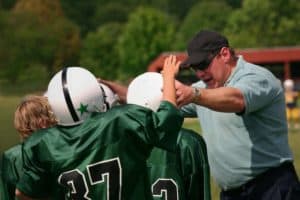
The 5 Most Effective Ways to Stop Bullying in Youth Sports
Kids play sports for a variety of reasons: to make friends, to stay active, and, first and foremost, to have fun. Unfortunately, the presence of a bully on a team has the potential to overshadow all of the best parts of playing youth sports. According to the National Alliance for Youth Sports, one in seven children in grades K – 12 is a victim of bullying or is a bully themselves. The group dynamics of a sports team can make young athletes especially susceptible to bullying.
While a little bit of conflict is inevitable when you get a group of children together, it is possible to drastically reduce incidences of bullying on a sports team. Rocky Top Sports World has put together a few of the most effective strategies for preventing and stopping bullying.
1. Establish a Zero-Tolerance Policy
The best way to stop bullying from becoming an issue is to nip it in the bud by creating a positive team culture. When the season begins, the coach should set clear expectations for what sorts of behaviors are and are not appropriate. It is important that the coach, and any other authority figures on the team, establish a zero-tolerance policy. This means that bullying, teasing, name-calling, or mean-spirited behavior in any form are not acceptable, even if the perpetrators view their comments as a joke.
2. Show Athletes the Right Way to Behave
In addition to explicitly stating which actions are not allowed, it is important to encourage behaviors that improve relationships on the team. Coaches and parents should model the sort of positive interactions they hope to see on the field. For example, adults could role-play a short scene where an athlete misses a crucial shot, but his teammates offer support instead of blame.
3. Break Up Cliques and Facilitate Team Bonding
Of course, not everyone on a sports team is going to be the best of friends. However, the existence of cliques on a team can lead to bullying, especially if a group of kids attempts to exclude one of their teammates. Coaches can help to break up these cliques by organizing practice in such a way that young athletes are forced to interact with kids who are not in their friend group. Team building exercises are also a great way to reinforce the fact that everyone is on the same side, working toward the same goal. For some inspiration, check out four of our favorite team building activities.
4. Encourage Players to Speak Up
While coaches do their best to notice and stop incidences of bullying when they occur, it isn’t possible for them to see and hear everything. It is important that kids on a sports team feel comfortable coming to the coach when they are being bullied. Good coaches take the time to listen to their athletes’ concerns and to deal with them as quickly as possible. Sometimes, kids find it easier to talk with their parents about bullying, so it is vital that parents and coaches have an open line of communication.
 5. Have Clear Consequences for Bullying
5. Have Clear Consequences for Bullying
If bullies feel like they can get away with their actions, they will have no reason to stop their hurtful behavior. It is imperative that coaches deal out appropriate and consistent consequences if and when incidences arise. Obviously, each instance of bullying is different, so punishments can range from sitting on the bench during a game to being suspended from the team for a certain amount of time. Coaches will also want to talk with the bully and her parents in order to figure out what motivates her bad behavior and how they can stop it.
Here at Rocky Top Sports World, we are a bully-free zone where good sportsmanship always comes first! Located minutes away from downtown Gatlinburg, TN, our 80-acre sports campus is one of the top tournament destinations in the United States. With seven fields, six basketball courts, 12 volleyball courts, team rooms, and an onsite grill, our athletic complex has everything you need for an unforgettable sports event. To see a complete listing of our upcoming tournaments, browse the Rocky Top Sports World Events Calendar!






